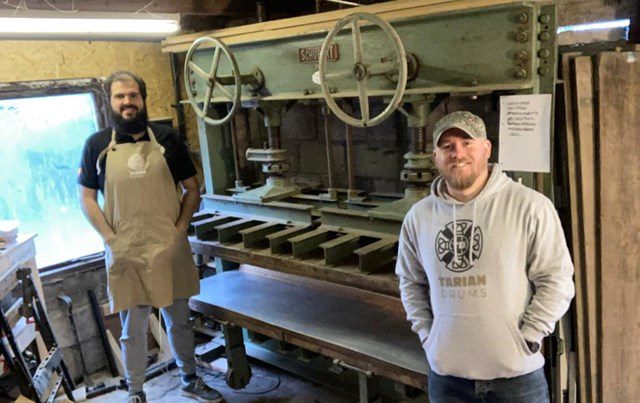A new set of specialist words has been added to a Welsh dictionary as part of the development of an app to help drummers design new instruments.
The terms for different types of drums, and parts of the instruments, have been developed after Pontyclun-based Tarian Drums turned to the Centre of Excellence in Mobile and Emerging Technologies (CEMET), which is based at the University of South Wales (USW), for help in building a bilingual online portal to support its business expansion.
A new set of specialist words has been added to a Welsh dictionary as part of the development of an app to help drummers design new instruments.
The terms for different types of drums, and parts of the instruments, have been developed after Pontyclun-based Tarian Drums turned to the Centre of Excellence in Mobile and Emerging Technologies (CEMET), which is based at the University of South Wales (USW), for help in building a bilingual online portal to support its business expansion.
CEMET, which is part funded by the European Regional Development Fund (ERDF) through the Welsh Government and supports Welsh SMEs with the creation and adoption of emerging technology, was approached by Tarian directors Rhys Thomas and Geraint Frowen, who were looking to find new customers.
Having developed the app, which is used by drummers to design their own instruments, Rhys and Geraint, who established Tarian and 2018, realised that some of the terms used by the performers didn’t have a direct Welsh translation.
“To solve the issue we got in touch with experts at Y Termiadur Addysg, which is a Welsh Government-sponsored project which provides standardised terminology for the field of education,” Rhys said.
“These are the terms to be used in Welsh medium exams and assessments and in resources of all kinds for teachers and students.
“The team there helped us to give definitions to specialist terms used by drummers – including Bearing Edge – Ymyl y Gragen; Butt end – Pen Bôn; Snare off/Throw off – Taflwr Tannau/Gwifrau;
Snare throw/snare off lever – Lifer Taflwr Gwifrau/Tannau; Rack Toms – Tomau Mowntiedig; Floor Toms – Tomau Llawr; Tension Rods – Rhodenni Tyniant; Snare Bed – Gweli Tannau/Gwifrau; and
Candy Marble – Marmor Candi.
“This meant the percussionists using the app could design their perfect instruments using the language of their choice.”
Gruffudd Prys, a terminologist at Bangor University who works on Y Termiadur Addysg, said that translating the words from English to Welsh was not as straightforward as just finding a direct match, as words could often have more than one meaning.
“The obvious example that arose during our work with Tarian was ‘snare’. The English noun ‘snare’ originally referred to a string or wire-based trap that you would use to ‘snare’ small animals, but it’s use has been extended to also refer to a type of drum that uses wires on its underbelly to give it its distinctive sound,” Mr Prys said.
“However, we couldn’t just use the Welsh equivalent for ‘snare’ for the drum because the Welsh word is associated to strongly with the sense of ‘trapping’.
“As it happened, we found that two Welsh terms were already in use for a ‘snare drum’: ‘drwm gwifrau’ (wire drum) and ‘drwm tannau’ (string drum). In discussion with Tarian we decided that the meaning of ‘wire drum’ (‘drwm gwifrau’) was more appropriate, and did not suggest that a ‘snare drum’ was somehow a ‘stringed’ instrument.
“This illustrates the importance of working with subject field experts such as Tarian who understand the concepts being discussed. Understanding the concepts ensures that we can select the most appropriate possible term for use in our dictionary.”
Will Warren, Senior Programmer at CEMET, explained how the app was put together.
“Together, Tarian and CEMET developed an Augmented Reality application which provides users with the ability to design customised drum kits and then virtually place them within their own space,” said
“One of the core aspects of the application is correctly representing the quality and dedication to customer service that Tarian Drums offer. This was achieved through accurately reflecting the level of detail involved in the drum design process, fully supporting both English and Welsh languages, and offering straightforward, native ways for users to connect with Tarian Drums.”
The work Tarian did with CEMET to develop the bilingual app was just one aspect of the support the company received from USW.
Mr Thomas initially approached USW Exchange, the front door for business engagement at USW, after facing challenges in developing the enterprise and coming up with a long-term solution to making moulds for bespoke drums.
“We felt like we were facing an uphill battle, and we weren’t winning at all,” he said.
“We spoke to the team at USW Exchange, and they suggested we go through the Partnership and Engagement Programme. This provided us with funding for academics in the engineering department to explore our ‘mould’ problem and try to find a solution.
“It was a no brainer – it had been costing us a lot to experiment, and now there was an opportunity for skilled engineers to experiment with the assurance of the grant from the programme. We met with the Head of Mechanical Engineering, who suggested 3D printing the mould. They created a prototype for us, and it was perfect.”
Rhodri Ryland, External Engagement Manager at USW, said the Tarian relationship is a perfect example of how similar partnerships can help a business thrive.
“Academic-industry collaboration can play a vital role in addressing the challenges faced by SMEs and businesses. The sharing of ideas, knowledge transfer and combined expertise can often unlock what appear to be the most difficult of problems and frequently provide solutions that might otherwise seem unachievable,” he said.
“The opportunities for academia and industry to support one another are vast, from graduate recruitment right through to research, innovation and development, and I would encourage all organisations to consider and explore how they can integrate academic-industry collaboration into their strategic ambitions.”









Leave a Reply
View Comments